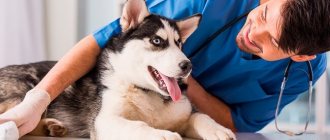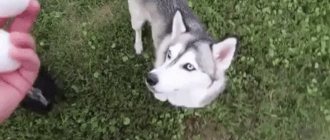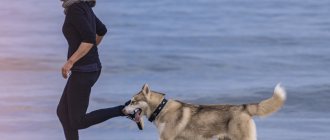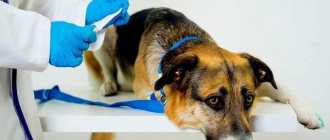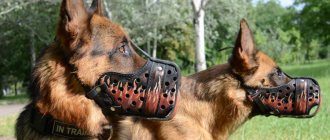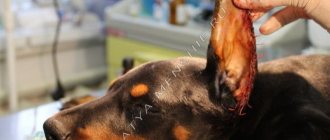Indications for castration
Owners of male Spitz dogs note in their reviews that pets that have reached puberty and strive for “love” lose their appetite and tend to run away from home.
Walking down the street all the time during heat is problematic, but at home the dog has to be kept in diapers, as it marks everywhere. In such a situation, the question always arises whether it is necessary to castrate the Spitz so that he becomes calmer.
Dog handlers believe that if a male dog has no prospect of becoming a breeding dog and mating at least 2-3 times a year, he should not be untied. In addition, castration of Spitz dogs is considered by them as the prevention of a number of diseases.
Castration of a male dog (orchiectomy) is advisable if:
- The male is not planned as a breeding dog.
- Participation in exhibitions is not provided.
- The dog is actively trying to dominate.
- For the prevention of diseases of the genitourinary area, prostate gland, paraanal glands, neoplasms of the testes.
- With increased hypersexuality. If the Spitz tries to mate with objects, the legs and arms of a person.
- Baldness of the trunk associated with an imbalance of sex hormones.
- Cryptorchidism (when 1 or both testes remain in the abdominal cavity and do not exit into the scrotum). Often a tumor forms on such testes, so any pathology of the testes is an indication for the procedure.
Doctors note that in some cases, castration helped the dog overcome allergies. This is not confirmed by research, but only observations by veterinarians.
Seam processing
During the postoperative period, you need to carefully monitor your pet's suture. When castration and sterilization of bitches, a fairly large incision is made, so problems arise with it and swelling and swelling of the suture often appears.
The process of restoring a male dog in this part is easier. Their surgical wound is small. Due to the accumulation of lymph, swelling of the scrotum may occur within 5-7 days, but this is the norm, a protective reaction of the body.
Expert opinion
Anna Abramenko
An avid dog lover. Experience in veterinary medicine since 2009.
Ask a Question
To prevent the dog from licking the seam, it is better to put a special bandage on it and make sure that the pet does not remove it and chew it.
As a rule, veterinarians remove stitches at 10-14 days, in some cases earlier. At this time, the owner is required to regularly treat the dog’s stitches. The doctor operating on the pet should tell you how to do it correctly.
The procedure does not cause any discomfort to the animal. On the contrary, it relieves the itching and tightness of the skin that appears during wound healing. The treatment is carried out with any antiseptic, softening the crusts. It is important that it does not contain alcohol. Hydrogen peroxide is best.
You also need to remove all dirt around the wound, then blot it dry. After this, the seam is lubricated with Levomekol ointment or other healing and anti-inflammatory agent. If the situation is favorable, after a few days it becomes dry, the surrounding skin has no redness, and the swelling gradually subsides.
The wound healing process does not always go smoothly. The reason that the suture does not heal for a long time is infection or rejection of the material.
The owner should be alert to the following signs:
- discharge from the wound, especially containing pus, blood, separation of its edges;
- the treatment procedure causes pain to the dog;
- swelling that does not subside within several days;
- hot skin;
- unpleasant smell.
Expert opinion
Anna Abramenko
An avid dog lover. Experience in veterinary medicine since 2009.
Ask a Question
In these cases, consultation with a veterinarian is required. There is a high probability that the pet will need wound treatment under anesthesia and re-suturing.
Advantages and disadvantages
Veterinarians believe that Spitz dogs can and should be castrated/sterilized. Especially if they do not participate in breeding, are removed from it for some reason and there are no contraindications to surgery.
The procedure has pros and cons that must be taken into account. Pros of castration:
- Dog behavior is changing. They stop being aggressive towards other dogs.
- The pet stops dominating the owner and children.
- The dog does not mark his territory and is easier to train him to wear a diaper.
- The animal does not jump on things, toys, arms, legs with characteristic movements.
- A male dog does not seek to run away from home in search of love.
An equally significant advantage is the increase in life expectancy. On average, Spitz live 14 years, and surgery will extend life by 1.5-2 years.
Castration is not a behavior correction method. It will not make the Spitz more obedient, less active, and will not instill love for children if it was not there in the first place.
Castration does not affect training and education in any way. The Spitz does not become less active or lethargic. The male who loved to play remains just as active.
- There is a risk of complications during and after surgery. For example, infection, suppuration of stitches or licking by a dog.
- There are also disadvantages of castration, which are associated with risks during anesthesia. However, the operation is quite simple and all surgeons do it, so the risks are minimized.
- The owners are worried that the pet will become fat. Yes, neutered animals are more prone to gaining excess weight. However, obesity can also occur in an uncastrated dog due to poor nutrition and overfeeding of the animal. After the procedure, you need to review the diet, reducing the calorie content of the feed by 10%. With proper nutrition and exercise, your Spitz will not get fat, as many dog owners think. It is not the fact of castration itself, but an incorrect attitude towards feeding that is the main reason for weight gain.
- Owners are no less worried that surgery on the genital organs is the cause of the development of urolithiasis. Studies have shown that castration does not affect the development and function of the urethra.
Myths about spaying a Spitz
I think the first thing to do is to sort out the most common myths that arise in your head when you hear the word “sterilization.” Only by discarding the following misconceptions can you begin to understand the issue in more detail:
- Many novice dog breeders are convinced that the pet will become more than well-fed and apathetic in the blink of an eye. I can say that excess weight is possible only due to genetic predisposition, a sedentary lifestyle and improperly organized nutrition. In general, the factors are the same as without surgery. Of course, the Spitz's metabolism is disrupted, but active exercise and a reasonable attitude to nutrition will help keep the animal in shape.
- Sterilization is cruel. For some reason, people begin to project the situation onto themselves. In fact, this is a huge mistake, since the Spitz, like all other animals, lives sexually purely for reproduction. The dog does not dream of the happiness of fatherhood or motherhood - when the puppies reach adulthood, they can treat them as complete strangers. I think, in this regard, it is clear that sterilization will not bring moral suffering to a pet.
- Sterilization is unnatural. In principle, it is difficult to argue with this. However, there is a rather significant “but” - raising a dog at home is not initially something natural. Nevertheless, we try in every possible way to ensure that our beloved Spitz enjoys a good upbringing.
Castration options
There are several methods for castrating dogs:
- Classic - an incision is made in the scrotum, the testes are removed, a special thread is placed on the cords and the testicles are cut off.
- The second option is to use a special adhesive agent instead of a thread, which eliminates bleeding.
- Another option is a biological node. It differs little in effectiveness from the first. The spermatic cord and vessel are removed and tied together. The testis is removed.
- Chemical castration. A method in which an implant containing a hormonal drug is inserted.
The advantage of chemical castration is its reversibility. 6-12 months after the procedure, the male dog begins to be interested in the opposite sex again.
How does the procedure happen and how long does it take?
The operation is performed under general anesthesia
The operation is performed under general anesthesia. Lasts about an hour for males, longer for females, approximately two hours.
The testes are removed through an incision in the scrotum. Ovaries and uterus through an incision in the peritoneum.
After surgery, the dog is placed on a bed until the anesthesia wears off.
Chemical castration
The essence of chemical castration is the administration of a drug that blocks the production of sex hormones.
After administration, the drug begins to act after 4-5 weeks: libido decreases, the size of the testicles decreases by 2-3 times. The male becomes calmer, does not run after females in heat, and is not aggressive towards other males.
After a certain period after castration (six months or a year, depending on the dose), the administered drug ceases to act, and the animal’s sexual functions are restored.
After 5-10 weeks, the dog fully restores its ability to reproduce. The advantage of the drug is that if the owner wants to breed a male dog, the implant can be removed if more than 4 months have passed.
Most often in their practice, doctors use the drug Suprelorin (the active substance deslorelin). This is a non-steroidal contraceptive. An implant is inserted subcutaneously, from which the substance is continuously and slowly absorbed into the blood.
However, chemical castration is an expensive procedure. The drug itself is also quite expensive. But it has advantages. It is indicated in the following cases:
- Temporary castration is required.
- If you need to find out what is causing the dog’s aggression. If the incorrect behavior disappears when the implant is inserted, then you can decide on classical castration. You should not expect your dog's behavior to change immediately after surgery. At first, the Spitz may behave the same as before castration, and only over time does the behavior change.
- As part of complex therapy for prostate hyperplasia.
- Treatment of alopecia X, a pathology that affects Pomeranians. It is used in both males and females.
Do I need to sterilize?
Spitz castration is a surgical procedure during which the reproductive organs are removed. This operation is performed if the owner does not plan to breed offspring or for medical reasons.
To castrate a Spitz or not is a controversial question that every owner of these dogs certainly asks. If your dog has serious breed deviations from the standard, chronic diseases, or you simply do not plan to burden yourself with caring for the offspring, do not hesitate to sterilize your Spitz.
Many veterinarians recommend surgery to correct the dog's behavior and prevent consequences associated with health problems.
At the vet
Preparation, performance and care after surgery
The day before the operation, the dog is put on a starvation diet. The animal is allowed to drink only water. The operation time is short - 15-20 minutes.
Stages of castration in the classical way:
- The dog is given anesthesia at the withers.
- Antiseptic treatment is carried out.
- A longitudinal incision is made in the scrotum.
- The testes are removed.
- Sutures are placed on the scrotum.
In the clinic (most often according to indications) the scrotum can also be removed. As a result, it looks more aesthetically pleasing, but more expensive.
The postoperative period in males is short. The owner will be required to monitor the pet, since immediately after the operation the animal recovers from anesthesia for a long and difficult time. Chills, nausea, and unsteady gait are noted. The dog may walk under itself and be disoriented in space.
Within 2-10 hours the male comes to his senses. At home, the seams are treated with an antiseptic or ointment, which the doctor will prescribe. Treatment is carried out 1-2 times a day for 1.5-2 weeks.
Males are advised to wear a protective collar to prevent them from licking the stitches. No bandages are applied.
The sutures are removed in a veterinary clinic or at home after 10-12 days. There are practically no postoperative complications in male dogs.
Shipping
Expert opinion
Anna Abramenko
An avid dog lover. Experience in veterinary medicine since 2009.
Ask a Question
The trip should be carried out as carefully as possible, sudden movements, shaking, and collisions with uneven roads should be avoided.
You need to start caring for your dog immediately after surgery. The primary goal is to get your pet home without any unpleasant consequences. Even if he woke up in the clinic, you shouldn’t lead him on a leash. The dog still doesn’t have enough strength for this.
If the pet is small, you can carry it home in your arms; if it is large, you need to find transport.
When transporting an animal, you need to cover it with a warm blanket, since anesthesia slows down all processes in the body and lowers the temperature. In addition, involuntary urination is possible, so it is better to place a disposable diaper under the dog.
There is no need to object when the veterinarian advises leaving the animal under observation overnight. This happens if the pet experiences severe discomfort, painkillers do not help him, he is too lethargic and weak.
At a veterinary clinic, a doctor will be able to monitor the dog’s condition and, if necessary, provide specialized assistance.
Spaying a female Spitz
Among many owners, there is a widespread belief that mating is inherent in nature or mating is necessary for health, and some people want to cuddle the cubs. However, dogs are not people. They do not enjoy mating. For animals, this is behavior at the level of instincts.
It is known that due to the small size of the Spitz, childbirth occurs with complications. They often undergo a caesarean section. There is also a high risk of birth and postpartum injuries and hormonal disorders. All this does not add to the health of the dog.
Treatment of diseases arising after childbirth, the cost of a cesarean section is several times higher than the cost of prevention, namely sterilization.
Sterilizing dogs is not only about making life easier for the owner. First of all, it should be considered as a prevention of serious diseases.
In sterilized dogs, the risk of developing the following pathologies is significantly reduced:
- Pyometra, endometritis are diseases accompanied by an inflammatory process with the formation of pus in the uterus. These diseases are practically not treated with medications, only with surgery.
- False pregnancy, which often occurs in small breed dogs.
- Tumors of the mammary glands, uterus, ovaries. They affect the functioning of all internal organs and cause baldness and estrus disturbances.
Prevention of the above diseases is possible only by removing 2 ovaries and the uterus.
Sterilization is carried out in several ways:
- An ovariohysterectomy is when both ovaries and the uterus are removed. It is considered the best option. If the uterus is not removed, the risk of inflammation and neoplasms is high. A large incision is made along the linea alba of the abdomen. A blanket is applied to protect the seam. The bandage underneath will need to be removed and changed daily for 7-10 days.
- Ovariectomy – removal of only the ovaries. The incision required for the operation is small, so no special treatment is needed afterwards. A small incision on the side and an internal suture are possible, but only in young dogs.
- Ligation or soldering of the oviducts. The procedure is performed by opening the abdominal cavity or laparoscopy. However, the method does not eliminate estruses and false pregnancies.
If the Spitz does not bear offspring, then it is better to carry out sterilization at an early age - before the onset of the first heat (at about 5 months). Doctors note that if you sterilize a dog before the first estrus, the risk of cancer is reduced by 200 times, and when sterilizing a Spitz over the age of 1.5 years, it is reduced by only 4.
Sterilization is also carried out for diseases that are difficult to cure:
- polycystic disease;
- uterine tumors
- endometritis
- pyometra
- hematometer.
The use of contraceptives is not recommended. Their purpose is to stop one, maximum two heats. Long-term use provokes serious hormonal imbalances and inflammation of the uterus.
Source
Arguments against sterilizing your Spitz
Perhaps it’s time to talk about real contraindications that have a logical basis:
- The first thing to consider when sterilizing a Spitz is that this procedure, like any other surgical intervention, can have unpredictable consequences. A young, inexperienced specialist often makes mistakes. There is only one way out - to look for a highly qualified veterinarian. Otherwise, the animal will have to deal with infections, suture ruptures, and inflammation.
- However, even if the doctor is good, the Spitz may not tolerate anesthesia well. And at any age. This question is quite individual, therefore no one can warn against the problem.
- A Spitz may also experience the phenomenon of urinary incontinence. Perhaps it is appropriate to talk here not about age, but rather about the time that has passed since the operation. So, a similar unpleasant phenomenon can happen 3-7 years after the operation. As a result, the desire to castrate an animal leads to the development of acute or chronic urinary tract diseases.
If necessary?
Whether or not a Spitz should be neutered is a controversial issue among most owners. However, if the dog is not a breeding dog, and especially if it has serious deviations from the breed standard, or the owner does not want to burden himself with caring for the offspring, then the dog must be castrated.
Experts recommend thinking about castration of your pet, as very often this operation allows you to correct the behavior of the Spitz and prevent some health problems.
Will he stop marking?
In most cases, after castration, male dogs stop marking their territory, or at least do it much less frequently. After the operation, it is recommended to wash those places in the apartment where the dog previously marked, so that no odors remain and he does not mark out of habit.
Consequences
It should be remembered that castration causes sharp hormonal changes in the animal’s body, so at first the Spitz may behave differently than it behaved before. Often in the postoperative period there is lethargy, depression, sometimes the animal becomes very affectionate, and sometimes, on the contrary, aggressive. However, after time passes and the body’s hormonal levels are restored, as a rule, there is an improvement in the dog’s behavior for the better. Aggression almost always decreases, but the pet still remains active and playful.
pros
- Correction of behavior , which consists, first of all, in reducing aggressiveness, since often the cause of aggression is precisely an excess of hormones.
- Safety for the pet. Often, a dog under the influence of sexual desire can run away during a walk, run away from home, or disappear for several days. There is a risk that something will happen to the dog and it will not return at all, or will return exhausted, infected with infections and parasites. After castration, this problem is solved.
- Science has proven that neutered dogs live longer than non-neutered ones . This is because neutering prevents a number of health problems. The first is the stress to which a male dog can be exposed during sexual heat. Secondly, castration is a prevention of genitourinary diseases (prostatitis, oncology).
Arguments for sterilizing your Spitz
Now it's time to talk about the positive aspects:
- A fairly weighty argument is increasing the lifespan of a pet. The average age of a Spitz is 14 years. Experts say that after the operation he can live one and a half to two years longer.
- Another big plus is the calmness of the animal. His aggressive behavior towards other dogs and family members will disappear. The Spitz simply does not want to dominate, claiming the title of leader of the pack. As a result, he will become more obedient and easier to train.
- The animal will lose its tendency to wander. It will no longer intend to run away in order to find a partner. I should note that this applies to both males and females.
- The dog that has undergone the intervention will not feel the need to frequently mark the area around it.
- The risk of contracting certain ailments will be greatly reduced or even completely eliminated. I mean tumors, cysts, prostatitis, pyometra, transmissible sarcoma. I can say that a dog suffers from such diseases much more often than from anesthesia during sterilization.
At what age should you think about this issue?
But now the choice in favor of sterilization has been made and it remains to decide when exactly it is reasonable to do this. I think some readers are aware that in America a puppy often undergoes this procedure at the age of 6 weeks. Thus, the buyer purchases a ready-made, operated puppy. In that case, of course, if he does not plan to engage in animal breeding in the future. On the one hand, this decision seems logical. But how correct is it?
In fact, it is highly desirable that the baby undergoes a full course of vaccinations before surgery. That is, it is wiser to operate no earlier than the age of 4 months.
IMPORTANT: Many experts are confident that male dogs should be neutered no earlier than 6 months, and the optimal age for sterilization of female dogs is 4-5 months.
The fact is that males castrated before 6 months may experience delays in development and growth. It is advisable for bitches to undergo the procedure no later than the age indicated above because such a step will prevent the occurrence of tumors in the genital area. According to research, the risk of such diseases is reduced by about 200 times! At a later age, the bitch begins to go into heat and, accordingly, the likelihood of tumors increases.
I think it is now clear that it is not only too early, but also too late to subject an animal to surgery is inappropriate. At an older age, the dog may endure the procedure more difficult than it would have endured in his younger years.
Best age for castration
If Spitz females are recommended to be sterilized at 4-5 months, then the optimal age for castration of males is 6-9 months, but not earlier. The fact is that if a male dog is castrated before 6 months of age, he may experience developmental delays.
If the dog has diseases, then before castrating the animal, they need to be cured. This is especially true for kidney and cardiovascular diseases.
Late castration (in males older than 7 years) has negative consequences. During this period, indicators of general health have already decreased. Therefore, the operation is more difficult to endure and the sutures take longer to heal.
After care
The first few hours after surgery, as a result of general anesthesia, the animal may be disoriented in space. The owner needs to carefully monitor so that the pet does not injure itself.
What to feed?
For the first day, you can give your pet food that is easily digestible. Your pet must have water. However, if the dog has no appetite and refuses to eat or drink, there is no need to force it.
Since the metabolism changes after castration, and Spitz dogs tend to become overweight, the owner needs to carefully monitor the pet’s diet, do not overfeed, do not give high-calorie foods, and also provide sufficient physical activity.
Among ready-made feeds, it is better to give preference to special feeds for sterilized animals.
What to do?
To prevent your eyes from drying out, you can instill water. During the postoperative period, the dog should wear thick underpants or diapers to prevent the seam from licking. The seam must be treated with special products prescribed by the doctor. Sutures are usually removed 8-10 days after surgery.
Important! If severe bleeding or other adverse symptoms occur, contact your veterinarian immediately.
How to care for your Spitz after the procedure
But it’s not enough just to successfully choose the age for sterilization. It is also necessary to take care of proper care in the postoperative period:
- It is highly undesirable to ignore a veterinary examination. The fact is that quality care includes antibiotic therapy. In this case, I don’t think it’s right to give comprehensive advice, since the timing and components of such therapy should be prescribed by a doctor on an individual basis.
- Immediately after sterilization, the pet should be placed on a flat surface covered with something.
- Under no circumstances should you give too much liquid! Just wet your tongue and nose with a little water.
- It is advisable to start feeding only on the second day. It must be soft food - for example, minced meat or pate.
- The seams must be constantly monitored to protect them from getting wet. I recommend using antiseptics for at least 10 days.
- It is also advisable to build a kind of collar or blanket for your pet. Any of these devices can prevent the dog from becoming more interested in the operated area. After all, it often happens that an animal seeks to clean the very place that has undergone surgical intervention.
Ask a Question
Some owners, despite the clearly outweighing benefits of sterilization, prefer to ignore this procedure. They prefer hormonal drugs. Of course, whether to decide to have surgery on your pet or not is everyone’s choice. However, according to experts, hormonal drugs cause disproportionately more harm than timely sterilization.
Castration is an operation to remove reproductive organs. It is done if the owner does not intend to breed puppies, as well as for medical reasons. The operation is performed only by an experienced veterinarian under sterile conditions using anesthesia.
Preparation
You need to take care of all necessary vaccinations in advance. Vaccination is carried out at least a month before surgery. In addition to this, the pet must be freed from all types of parasites, including worms and ticks.
Do not neglect examining the dog or limit yourself only to an external examination. The pet will undergo serious abdominal surgery under general anesthesia; checking the functioning of the cardiovascular system will not be superfluous. You also need to prepare urine and blood tests.
Immediately before castration, the dog is limited in food for 10 hours and in fluid intake for 6 hours.
Flaws
The disadvantages of sterilizing a Spitz include:
Neutered dogs are not allowed at shows
- Dogs that have been neutered cannot take part in exhibition events.
- After surgery, there is a tendency towards obesity.
- Surgery is performed under general anesthesia, and this can be a risk to the pet's health.
Owner reviews
“Spitz dogs are very smart and affectionate, and after castration they become even more affectionate than before; in general, they are a very cool breed, I recommend them to everyone.
Mine was neutered at 1 year 7 months. and they didn’t regret it at all, they completely stopped marking in the apartment, their activity didn’t change, they remained the same playful dog as they were, their appetite became better, they became more obedient, and castration had absolutely no effect on their fur.”
“I castrated mine when I was 2 years old. Patience is over. Walking on the street turned into some kind of horror. . It was impossible to let him run, he could run away somewhere without looking back, they were afraid that he would get lost altogether. He constantly squeaked, whined, howled, and could not eat, drink, or sleep.
It got to the point that after the guests arrived, he started marking everything in the house! I generally went to the litter box every other time, and then in the corners, next to it, but not in the litter box itself. It is clear that punishing is completely useless, it is an instinct.
The veterinarian also convinced me by saying that the dog is stressed all the time because of this sexual heat, it’s like an addiction, and stress is very harmful, especially in small breeds it can even lead to epilepsy. I finally decided to have her castrated.
They performed an operation and it took three days to recover. And then - an amazing result, it became absolutely perfect, absolutely adequate, calm. That's how the grandmother whispered, literally right away.
There are no problems with the toilet at home, just use the litter box, we walk quietly, don’t run away, eat normally, communicate normally and play with other dogs. The temperament and playfulness are the same. I don’t regret one bit that I agreed to castration.”
Advantages
The advantages of castration include:
- Behavior correction. Reducing aggression, which is caused by an excess of hormones.
- Safety for the Spitz. Due to sexual desire, a dog may run away during a walk or simply run away from home for several days. At this time, there is a risk that something will happen to her, or she will simply disappear, or return exhausted, infected with various infectious diseases and parasites.
- Lifespan. Modern research has proven that neutered dogs live longer than unsterilized ones. This is because dogs without reproductive organs do not have a number of health problems.
Castration is an excellent prevention of diseases of the genitourinary system.
Prevention
In most cases, cryptorchidism in dogs is a hereditary pathology, the occurrence of which is almost impossible to influence. The only means of prevention is a balanced and nutritious diet for the pregnant bitch, especially at the end of the period of gestation. In addition, the animal should only be paired with healthy males whose ancestors did not suffer from a similar problem.
As for acquired cryptorchidism, associated with injuries and infections, measures to prevent it include keeping the puppy in a warm and dry room, mandatory walks, a well-chosen diet, and timely vaccinations.
What is involved in caring for a dog after castration?
After castration, the dog can be left under the supervision of doctors or taken home. Placement in a hospital is carried out solely at the request of the owner, since independent care requires only 2 things - desire and free time.
Transportation home
If possible, it is better to transport the animal by car. If this is not available, it is recommended to use taxi services. If you have a small dog, prepare a comfortable, warm carrier for it, and if you have a large dog, take a blanket and plenty of disposable diapers with you so as not to stain the seat.
Before starting the trip, place your pet on its right side to reduce the load on the heart and avoid accidental entry of vomit into the trachea. Be sure to throw something warm on top. Anesthesia slows down internal processes, including thermoregulation. Without additional heating, the dog runs the risk of freezing even in warm weather.
Coming out of anesthesia
Place your pet on the floor until fully awakened. Due to poor coordination, access to elevated surfaces will have to be temporarily limited.
When arranging the place, use diapers and warm blankets. They will help avoid getting wet when involuntary emptying of the bladder, increase comfort and prevent freezing.
In addition to drafts, avoid being too close to heating devices. Excess heat can cause internal bleeding. The same applies to heating pads.
Important point
Be sure to moisturize your pet's eyes with artificial tears. Anesthesia prevents natural blinking, and the cornea dries out and is injured.
A clouded mind and poorly controlled paws can greatly frighten an animal. If it decides to hide under the sofa, try to prevent this so as not to have to worry about getting it out.
Don't swear and be as gentle as possible. This will reduce the resulting stress and prevent further escape attempts.
Also be sure to prevent any contact with children or other pets that could accidentally cause pain while playing together.
First day: you can drink, you can’t eat
Weakness, drowsiness and lack of appetite on the first day are completely normal. Due to the feeling of nausea, feeding may provoke vomiting, so it is recommended to temporarily avoid it. There is also a risk of choking or pneumonia due to food particles or liquid entering the lungs.
With water everything is different. You can not only drink, but also need to. In the first hours after waking up, the animal will not be able to drink on its own, so it will have to be given water from a syringe or pipette.
Day two: what to feed your pet
The fasting diet can last up to 3 days, but in most cases little interest in food appears by the second day. Despite this, it is still not worth loading the body. The serving size should be no more than ⅓ of the usual.
It is recommended to use low-fat and easily digestible foods, and when dry feeding - wet canned food. In addition to regular water, the animal is given chicken broth and low-fat kefir.
Diet until full recovery
After castration, the dog becomes active within 3-4 days. Despite this, it is better not to rush into returning to your usual diet. Until the sutures heal, you will have to adhere to a special diet, which includes:
- frequent feeding in small portions;
- the use of liquid foods (broths, watery porridges, fermented milk products or wet canned food);
- reduction of the usual daily calorie intake.
Feeding with dry granules is also allowed, but with one caveat. They will have to be soaked. Otherwise, problems with stool may occur.
When can you go for a walk?
Walking is allowed no earlier than the third day, when the four-legged dog can confidently stand on all 4 legs and drink water on its own. If the dog is small and goes in a litter box, then the quarantine can be extended to five days.
In the first 2 weeks you will have to exclude jumping and running. Take your pet outside only to relieve himself - and after completing all the tasks, immediately return home.
Hygiene in the postoperative period
Moisture slows down tissue regeneration, so it is better not to wash the animal until the stitches are removed. You can only wet the paws, and all other parts of the body should be wiped with a regular damp cloth.
Is a protective collar or blanket necessary?
A cotton blanket with ties at the back should be worn until the wound heals. It must be washed whenever it gets dirty and be sure to iron it on both sides to sterilize it.
In addition to the blanket, you will need a protective collar. It will protect you from scratching and licking wounds. If the dog behaves well and does not try to reach the wound, you can refuse the collar.
Seam care
The suture heals faster after castration of a male dog. The scrotum heals after a couple of days, and the wound on the stomach of bitches takes 7-10 days. All this time, the owner needs to keep it clean and dry. For treatment you will need cotton pads, chlorhexidine and levomekol ointment.
“Ordinary cotton wool will not work here, as its fibers can get stuck in the wound and cause suppuration.
Maintenance is not provided for self-absorbing permanent sutures; it is only needed for removable ones. Here it is better to follow the veterinarian’s recommendations, since in most cases simple observation and timely washing of the blanket are sufficient.
After the final disappearance of swelling and redness, the suture material is removed. Some owners prefer to do this themselves, but to be on the safe side, it is better to contact a veterinary clinic.
Spaying a female Spitz
Among many owners, there is a widespread belief that mating is inherent in nature or mating is necessary for health, and some people want to cuddle the cubs. However, dogs are not people. They do not enjoy mating. For animals, this is behavior at the level of instincts.
It is known that due to the small size of the Spitz, childbirth occurs with complications. They often undergo a caesarean section. There is also a high risk of birth and postpartum injuries and hormonal disorders. All this does not add to the health of the dog.
Consequences
Castration of a Pomeranian Spitz is caused by a sharp change in hormonal levels in the dog's body.
Immediately after surgery, your pet's behavior may change. Often after castration you can observe lethargy and depression in the dog. Some Spitz become very affectionate, and sometimes, on the contrary, aggressive.
After castration, a Spitz can become very affectionate
Do not worry! After a short period of time, the level of hormones in the pet’s body will stabilize, and its behavior will improve for the better. Owners note that in most cases, aggression decreases, but activity and playfulness remains at the same level.
Feeding dry food
For the last half century, owners have been pampering their pets with dry food. The main advantages of “drying” lie on the surface - you don’t have to “steam” and think through your daily diet, calculate the ratio of proteins and carbohydrates, and, after all, you don’t have to stand at the stove and cook.
Opening and pouring are the two actions that are required of you. In addition, a refrigerator and the necessary products are not always at hand. But if you have tender feelings for your baby, think about the following information.
Feed often contains such “pests” as pesticides, chemical additives, soy with its hard-to-digest proteins, hormones, cheap grains, salt in large quantities, synthetic additives, flavors and sweeteners.
Basically, the production of animal feed is a kind of appendix to the human nutrition industry. It is on the basis of waste from the production of human food that animal feed is made.
When feeding dry food, it is important to give your pet enough water.
It is believed that high protein foods lead to kidney disease. However, it all depends on the quality of the protein. It should be easily absorbed by the body, without forcing your animals to spend huge resources on its processing.
And finally. If you buy it, then only premium class.
In the first year of life, do not under any circumstances allow your Spitz to dry out; you can allow yourself to become lazy only during the period when your pet’s body is already fully formed.
Now it is fashionable and advisable to buy food characterized by the overseas word “holistic” (translated from Greek means holistic). This is a kind of super-duper premium class.
It uses only high quality products, the meat content ranges from 50 to 80%. In general, this is nutrition close to human nutrition.
How to choose the right dry food
When choosing dry food, consider the following criteria.
– meat comes first in the composition
– the protein is obtained from a high-quality source (whole meat, for example).
– artificial preservatives and colors
– processed meat by-products
Features of anesthesia and its consequences
The duration of the surgical intervention is less than an hour, but the owner is always given a margin of waiting time. This is necessary to recover from anesthesia. The speed of awakening depends on the type of anesthesia chosen:
- analgesics and muscle relaxants – 5-24 hours;
- epidural anesthesia and muscle relaxants – 8 hours;
- gas anesthesia - immediately after the anesthesia is turned off.
The first option is most often used, so full recovery occurs at home. At the veterinary clinic, they wait only for the moment when the four-legged animal opens its eyes and begins to respond to external stimuli.
In addition to the long awakening time, general anesthesia has other disadvantages:
- reduces blood pressure and temperature;
- reduces heart rate and breathing.
If you are intolerant to the administered drug, an allergy is also possible. More severe complications include pulmonary edema and stroke, but they usually only occur in older dogs and pets with chronic pathologies. Thanks to a thorough preoperative examination and individual selection of the dose of anesthetic, the likelihood of unpleasant consequences is minimal.
Behavior of a dog or bitch after surgery
Dogs behave differently after castration, so you should prepare for this in advance. The changes mainly concern their activity, so in order to avoid obesity, it is recommended to switch to low-calorie ready-made food or reduce the total calorie content of the natural diet.
Will my pet stop marking?
Leaving marks is practiced not only for the purpose of mating, but also to warn potential enemies. And if the first problem is really solved promptly, then the second most often persists.
Dogs neutered at an early age are less likely to mark territory, but if a competitor arises, even they are capable of this. In this case, the territorial instinct can be awakened by a new pet that has not yet been neutered.
Is it possible for females to go into heat?
Normally, estrus persists only after sterilization, since the production of hormones does not change. In bitches with tubal ligations, both the periodicity and accompanying symptoms persist.
They castrate according to a different algorithm, so the occurrence of estrus after total removal of organs always requires contacting a veterinarian and is usually explained by the following reasons:
- Preservation of a small fragment of the ovaries, that is, a surgeon’s mistake. An unnoticed piece can preserve almost full functionality of the removed organ.
- Neoplasms in the vagina. Malignant tumors that metastasize stimulate the production of sex hormones.
- Hormonal imbalances. In some cases, the function of the ovaries is taken over by the adrenal glands.
The last reason is the rarest. It can be eliminated with hormonal therapy. In other situations, you have to resort to repeated surgery.

